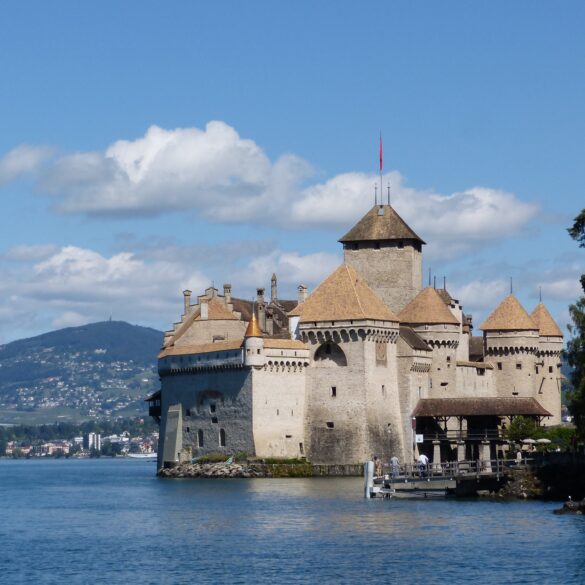Welp, it took us almost 4 years but we finally completed one section of the Deutsche Fachwerkstrasse or German Half-Timbered House Road.
The road had 7 sections and the one we completed, called “From the Westerwald via the Lahn Valley and the Taunus to the River Main”, is the second shortest.
It’s still 176 kilometers long, although we didn’t do it in order so we probably drove at least twice that distance in total to visit all nine towns.
The first town we visited way back in September 2012 was Limburg.

Its full name is Limburg an der Lahn, meaning that it lies on the Lahn River.
The St. George’s Cathedral, also called the Limburger Dom, can be seen from throughout the town
You can also see it from the autobahn as you’re driving past the town.
(By the way, if you’re a fan of the B-52s, you will have to restrain yourself from yelling out “I’m not no Limburger!” at every opportunity while you’re strolling around. Or maybe it’s just me who had to restrain myself.)
My favorite half-timbered house in Limburg was the 16th-century Haus der Sieben Laster or House of the Seven Vices.

The seven carved heads represent the seven deadly sins of pride, greed, envy, lust, gluttony, wrath and sloth.
Aside from the fabulous examples of half-timbered houses typical along this part of the route, Limburg has tons of shops, restaurants and cafés.

We treated ourselves to cake and coffee at Café Will, the oldest café in Limburg.

One last tidbit about Limburg, Germany.
It’s not the home of the stinky Limburger cheese.
That honor belongs to a region called Limburg that is shared by Belgium and the Netherlands.
The next town on the route that we checked out was Herborn, which we visited the last Sunday of May in 2013.
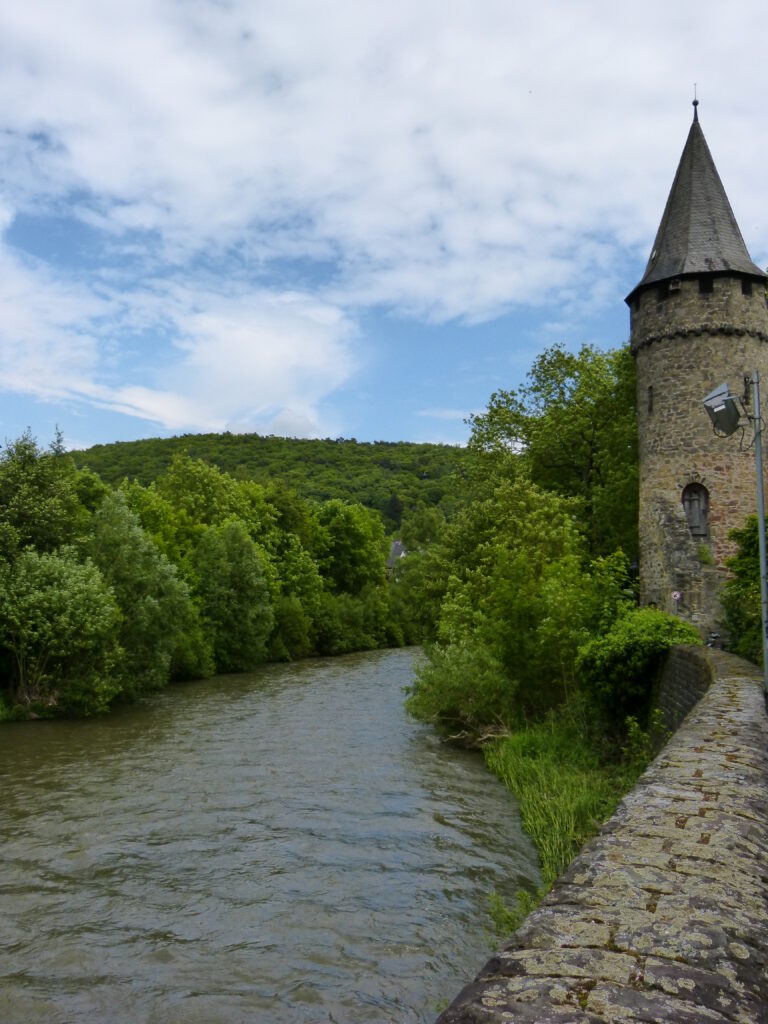
Herborn lies on the Dill River.
One of the first buildings we ran across was the town hall.
Although it was originally built in the 1500s, there was a big fire in Herborn in 1626 that destroyed more than 200 buildings.
The town hall was rebuilt after.
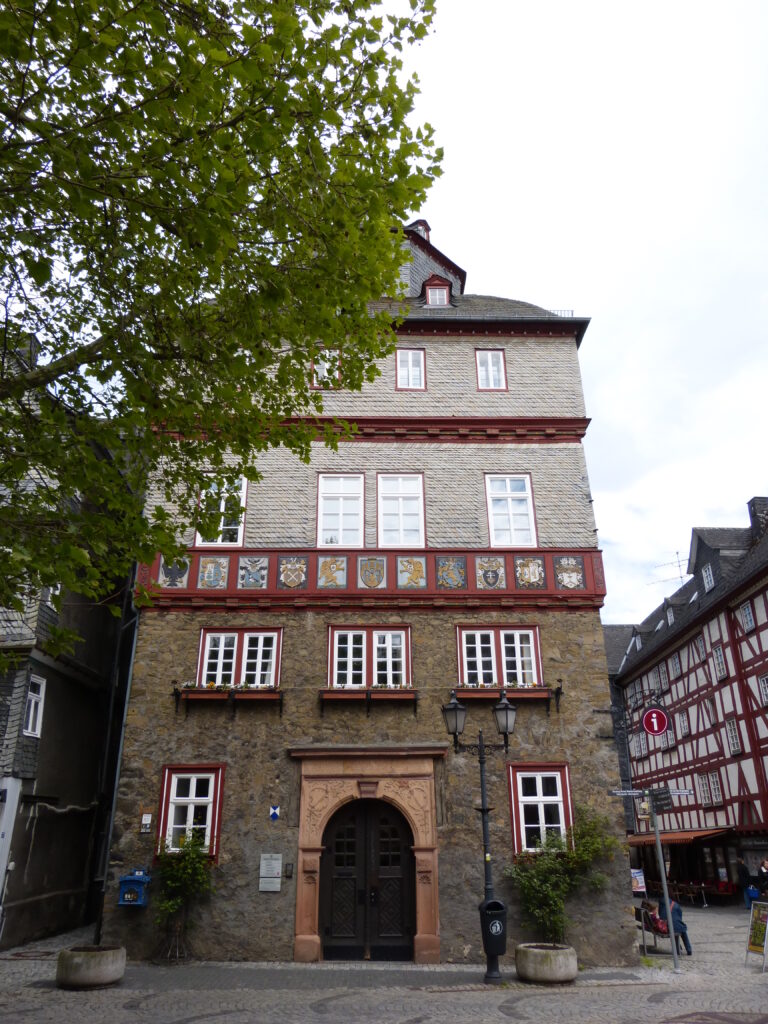
One of its most distinctive features is the frieze around the building containing coats of arms.
A short walk above the town brings you to the castle, which dates to the early 14th century.

It has served several purposes since then and today houses a seminary.
Before our trip to Herborn, I had recently read a book called The Hangman’s Daughter by Oliver Pötzsch.
The book takes place in Germany, I was interested to see that there is a house in Herborn that used to be the hangman’s house.
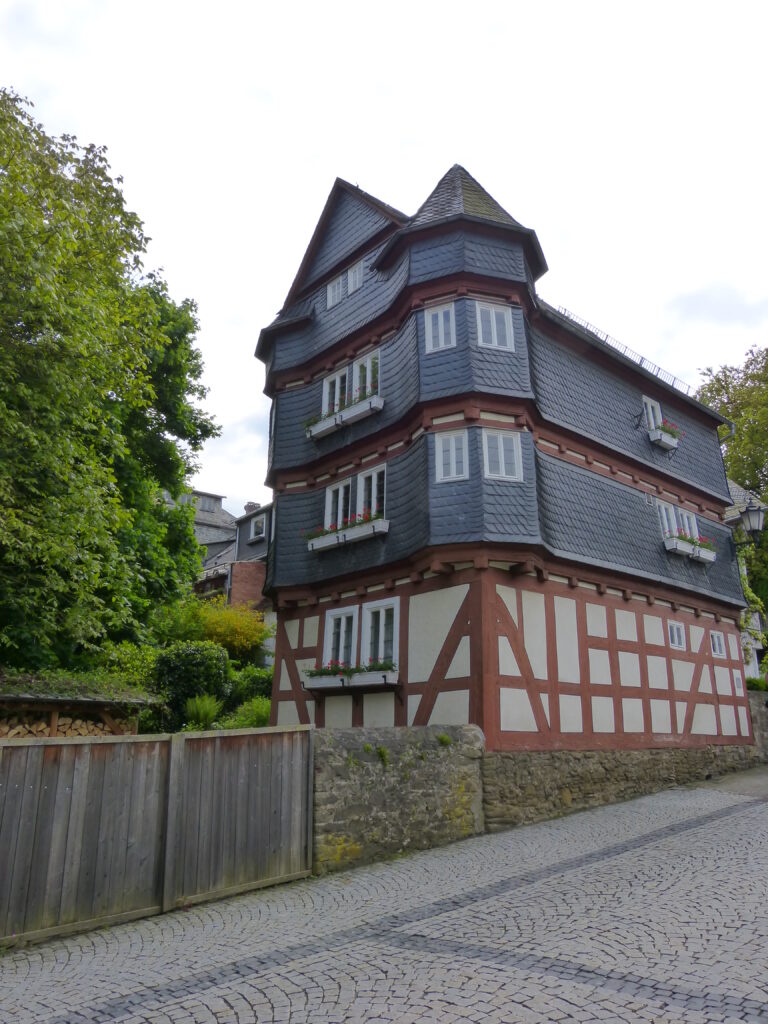
Some of the half-timbered houses in Herborn are unusual because of their height.
This one is five stories.
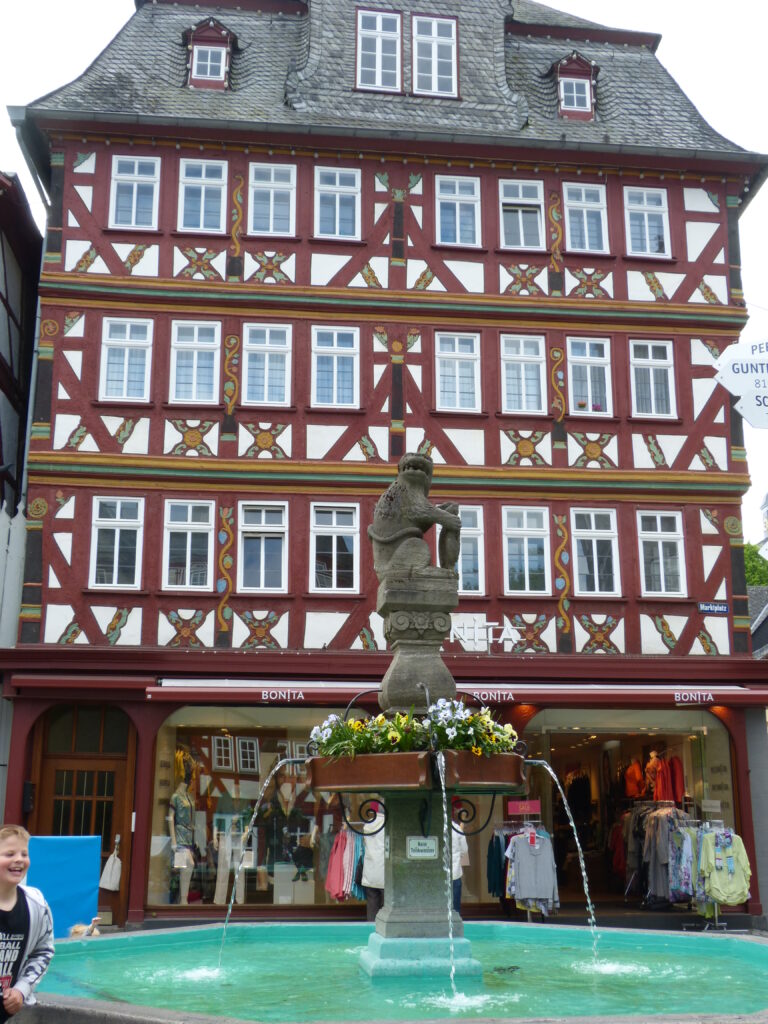
The fountain in front of it is from 1730.
The following Saturday after touring Herborn, we went to Wetzlar.
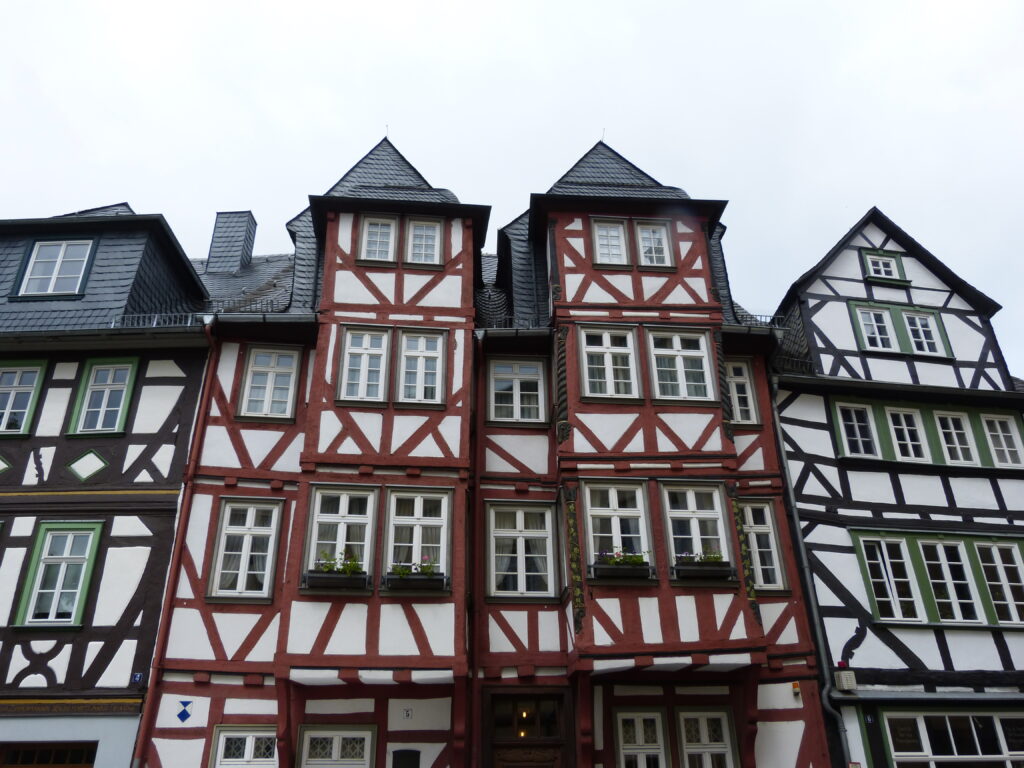
Like Limburg, Wetzlar lies on the Lahn River.
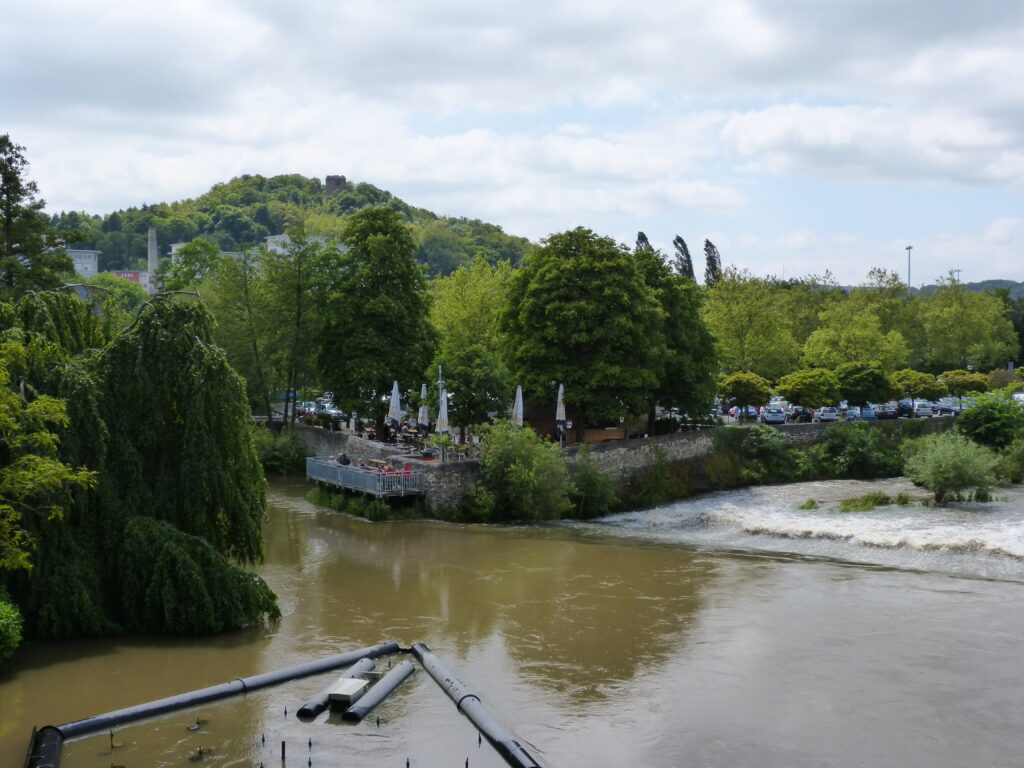
Although Wetzlar’s half-timbered houses are impressive, the town has some other great features including the cathedral.

You can see the different architectural styles.
That’s because the church was constructed in stages over the period of several hundred years.
It was also damaged by bombs during World War II and later restored.
One of the steeples remains unfinished to this day, almost 800 years after construction began.
In 1772, the German author Johann Wolfgang von Goethe stayed in Wetzlar.

Some of his writings were inspired by his time there.
For example, he met and fell in love with Charlotte Buff, who lived in this house and unfortunately broke his heart.

The character of Lotte in his book “The Sorrows of Young Werther” is based on her.
Have you ever heard of Leica cameras?
The Leica optics company, which also makes the cameras of the same name, is headquartered in Wetzlar.
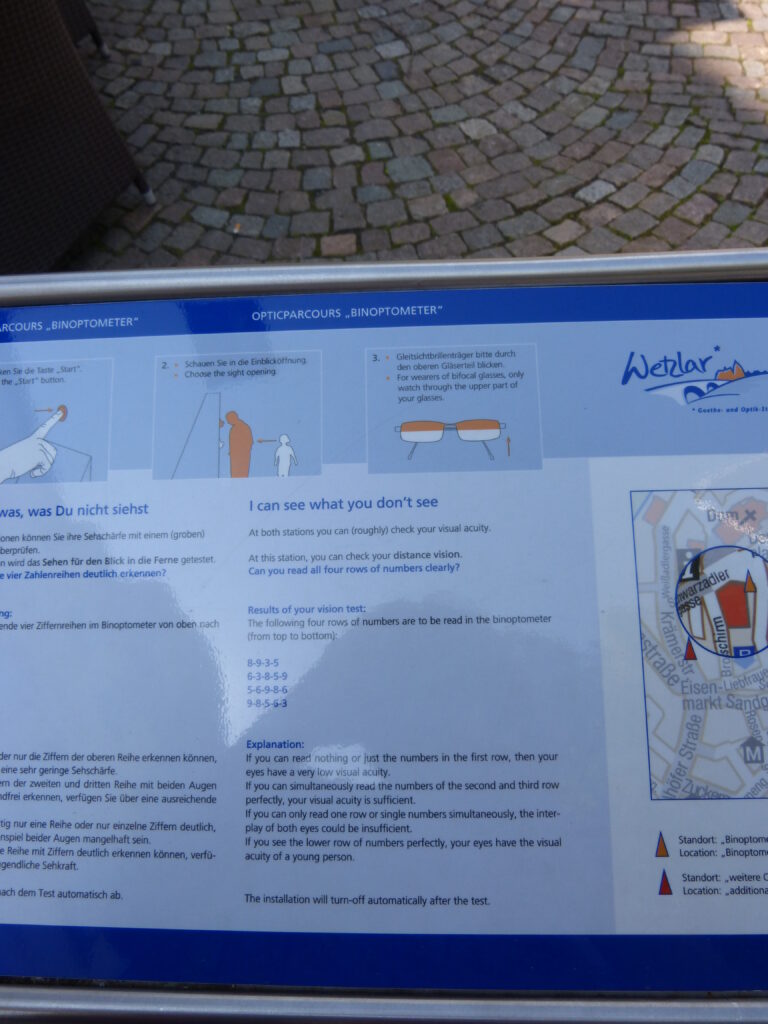
The company has placed machines like this all around town so that you can test things related to your vision.
There are helpful explanations on each machine, in English as well as German, to tell you what your results mean.
That one tested visual acuity.
My results said “Your eyes have the visual acuity of a young person.”
Of course that was three years ago, but still. I’ll take it.
The very next day after visiting Wetzlar, we went to Braunfels.

If the name of the town sounds familiar, it may because you know the city of New Braunfels, Texas in the United States.
It was settled by Germans from Braunfels in the 1840s.
At the time of our visit, to be honest, we weren’t even aware of the Half-Timbered House Road.
We just happened to visit three places on the route over two consecutive weekends.
Our main reason for going to Braunfels was not to see the houses but to see the Schloss (castle).
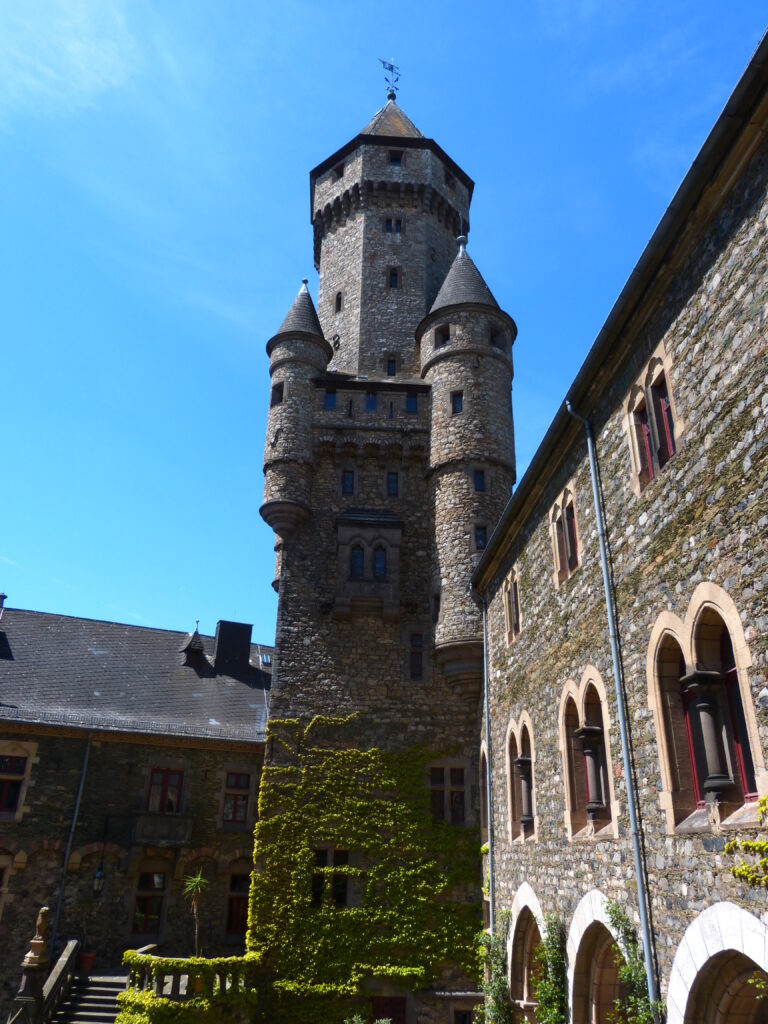
You can visit the inside of the castle only as part of a tour.
We ended up taking a German tour but it was fine.
Even with our limited German we got the gist, having been to enough other castles to know about weapons rooms and bedrooms and dining rooms etc.
Also, a bilingual woman on the tour was kind enough to translate for us when we looked confused.

You can exit the castle right onto this lovely square, where you can then enjoy the half-timbered houses and maybe have an ice cream or some other refreshment at one of the many restaurants.
After Braunfels, it was almost two years before we went to another town along this part of the route.
We went to Idstein at the end of Feburary in 2015.
We had actually been there once before, for the Christmas market in December 2011.
The market was so crowded that we really couldn’t enjoy the town, so we really wanted to make a return trip without the crowds.
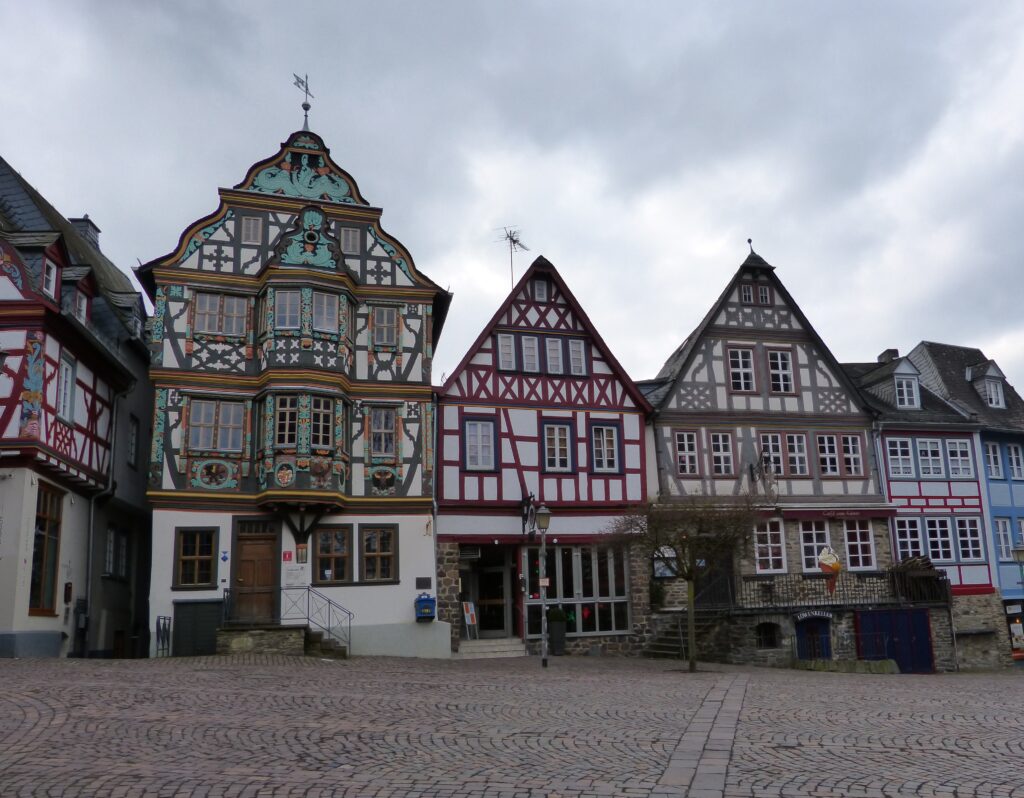
Since that trip, we’ve been back a few more times.
It’s one of my favorite day-trip towns, with one reason being that it’s only about a 30-minute drive for us.
Another is that the half-timbered houses there are absolutely stunning and it’s a great place to take visitors for a taste of that type of architecture.

The decorations on the houses here are some of the most elaborate I’ve seen in Germany.
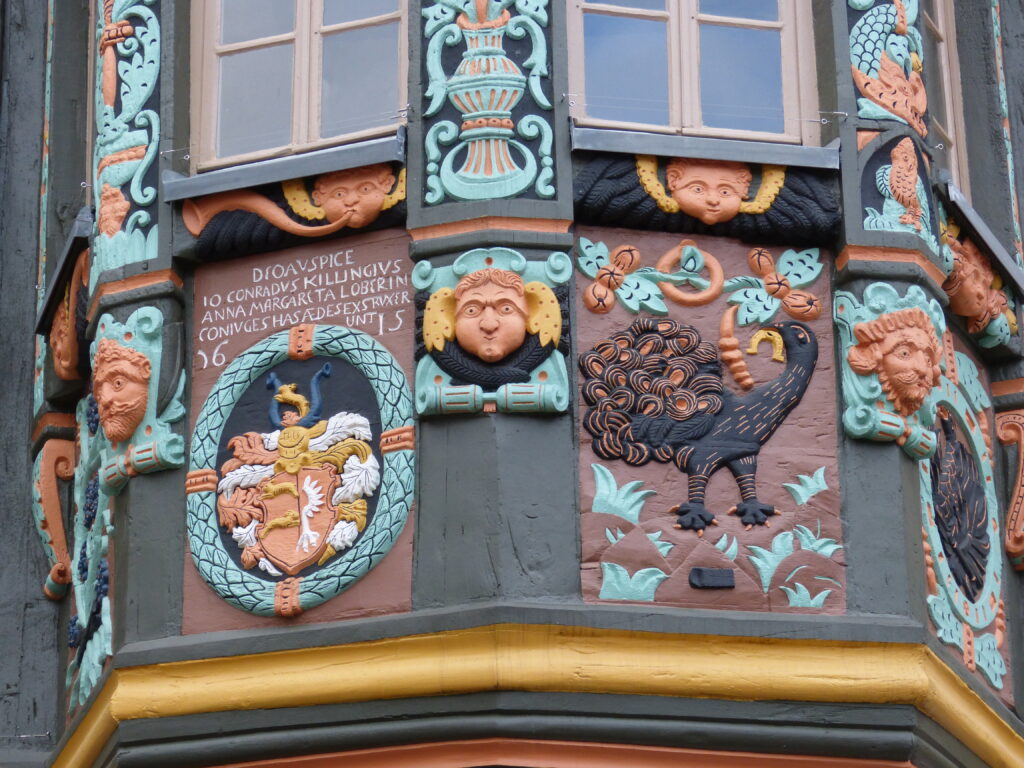
That’s a closeup of the Killingerhaus, the house on the left in this next photo.
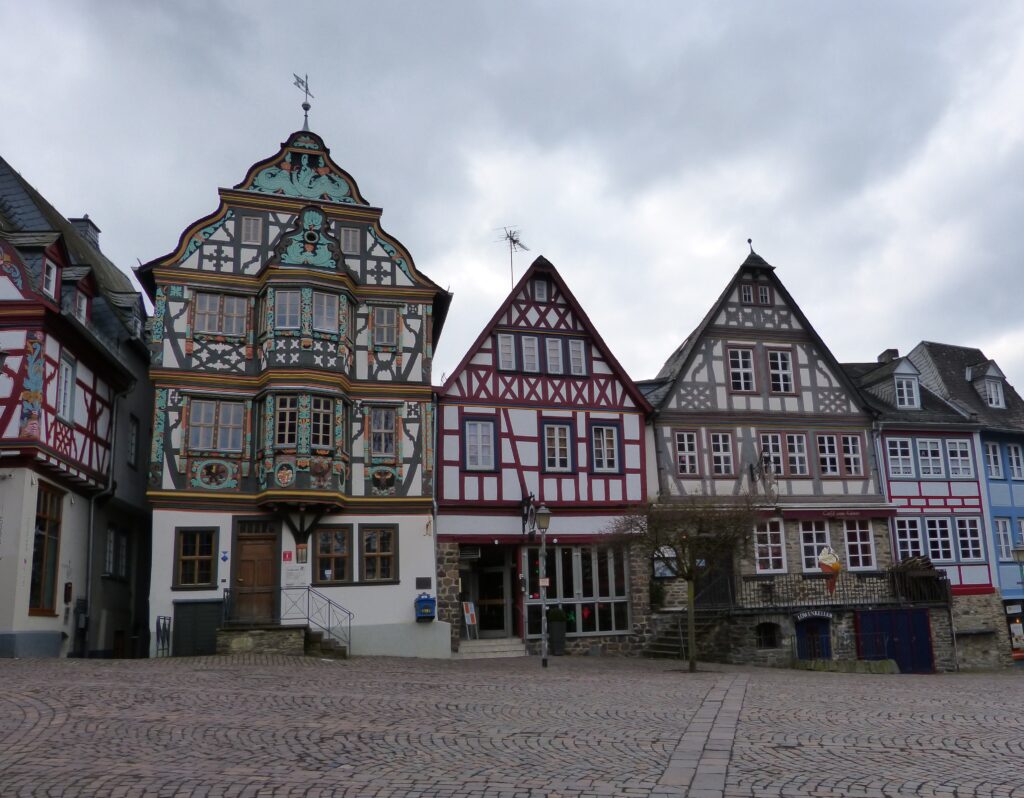
It’s named after Conrad Killing, who built it in 1615.
Amazing that it was 400 years old when we saw it.
The tourist information center is located in its ground floor now.
One of the most impressive houses in Idstein is this one.

You can probably guess why it’s called The Crooked House.
The crookedness is caused by deficiencies in the building’s construction.
With four stories, it’s one of the highest half-timbered houses in town.
Idstein is well-known for the witch trials held there in the 1600s and they really capitalize on the witch connection.

That’s the Witches Tower, originally built in 1170.
Idstein has a Hexenmarkt (witches market) every year, which is a fun medieval-themed market with crafts, food, drinks and entertainment.
The tower is part of the castle complex, which has a nice little garden and half-timbered buildings from the 16th century.
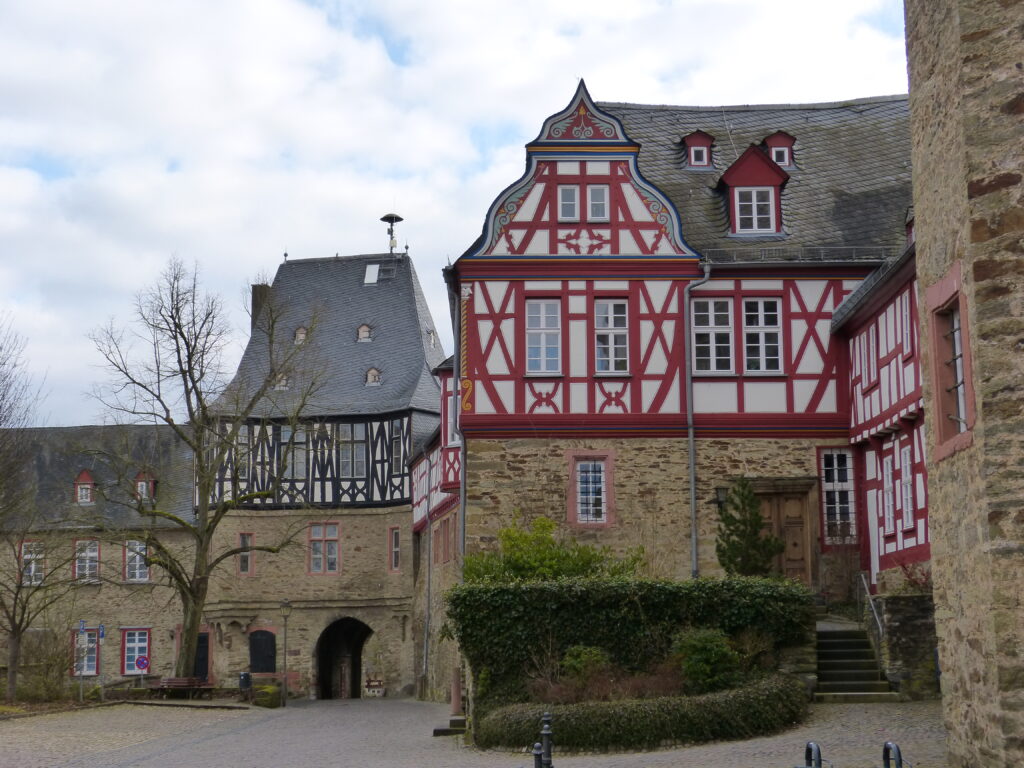
The building with the arch was originally the castle gatehouse, built in 1497.
It has also served as a prison, a torture chamber and a granary.
I always wonder about the progression of things like that.
“Well, Hans, looks like torture is becoming frowned upon by the townspeople. What should we do with this building now?”
“Klaus, stop your yammering and help me find somewhere to store all this grain.”
At the beginning of April 2015, we went to Dillenburg.
Like Herborn, Dillenburg lies on the Dill River.
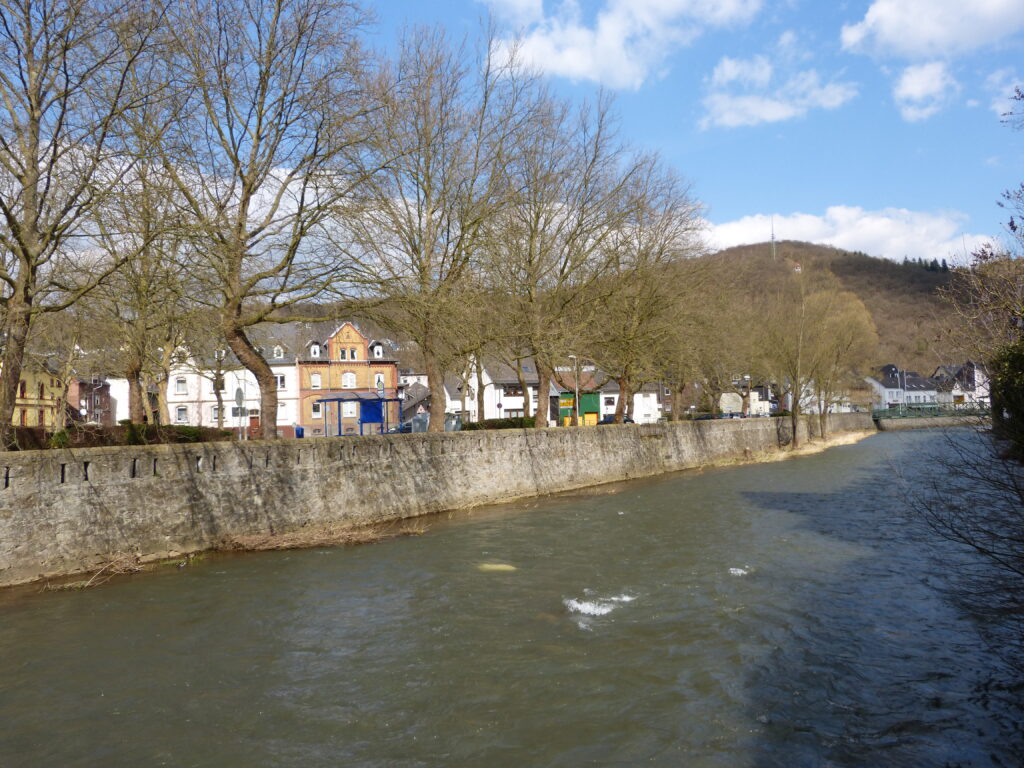
And like Braunfels, Dillenburg has a Texas connection.
The town of Fredericksburg, Texas – named after Prince Frederick of Prussia – was founded by John O. Meusebach (aka Baron Otfried Hans von Meusebach), who was born in Dillenburg.
Dillenburg also has a strong Dutch connection.

William of Orange, who led the Dutch revolt against the Spanish in the 16th century, was born in Dillenburg.
Dutch royals visit the town to this day.
One of the nice things about Dillenburg was that their informational signs were not only in German, but also in English and Dutch.
From the town, it’s a short walk up to the castle where William of Orange was born and lived.
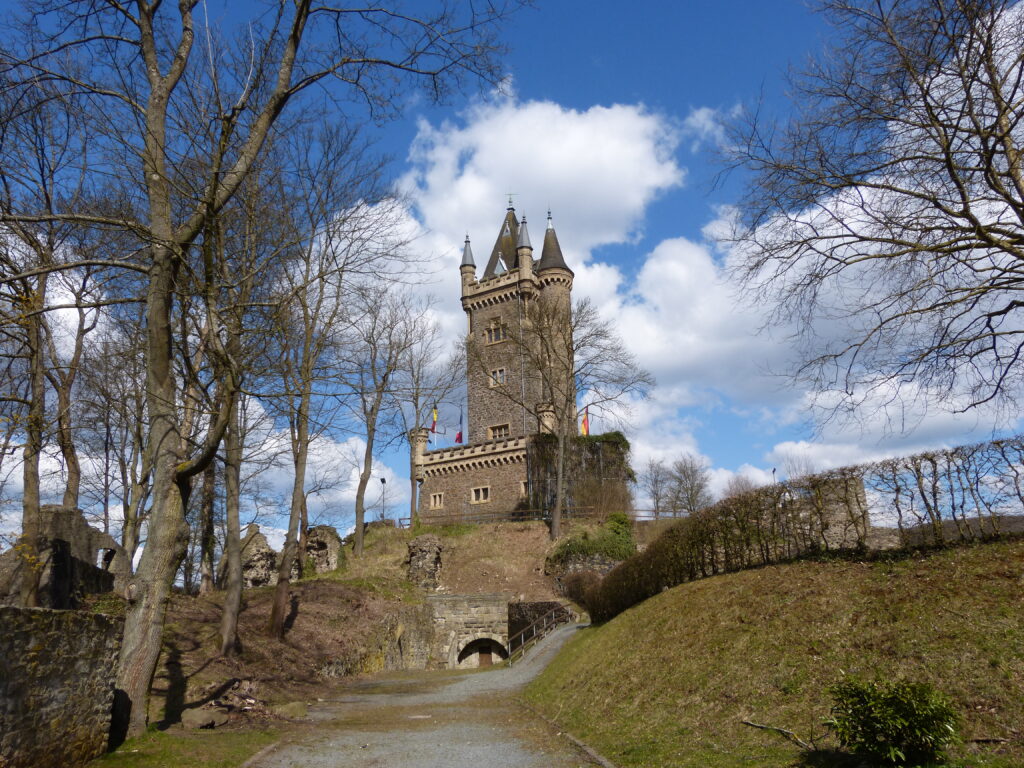
Look at those blue skies! We couldn’t have asked for a better April day during our visit.
The castle is visible from almost everywhere in town.

The castle tower houses a museum today.
One more fun thing about this town – horses!

Dillenburg is located in the German state of Hesse and the Hesse State Stud Dillenburg is there.
Horses have been bred there for over 400 years, and you can go and watch them being xercised and trained.
The town that was probably the most pleasant surprise was Höchst, which is a district in the city of Frankfurt.
I had been there once before to see a play and my initial impression of the town wasn’t great.
We’ve also passed by it when taking the train into Frankfurt and it doesn’t look like much from that vantage point either.
But when we visited there in July of 2015, despite the oppressive heat we ended up really loving the place.
The first thing we were surprised to find out is that Höchst has the distinction of being the only place in Frankfurt with ferry service across the Main River.

At this point the river is very narrow and that tiny little ferry just goes back and forth all day long between Höchst and a nature reserve in Schwanheim.
The second surprise is that there’s a palace near the ferry landing.
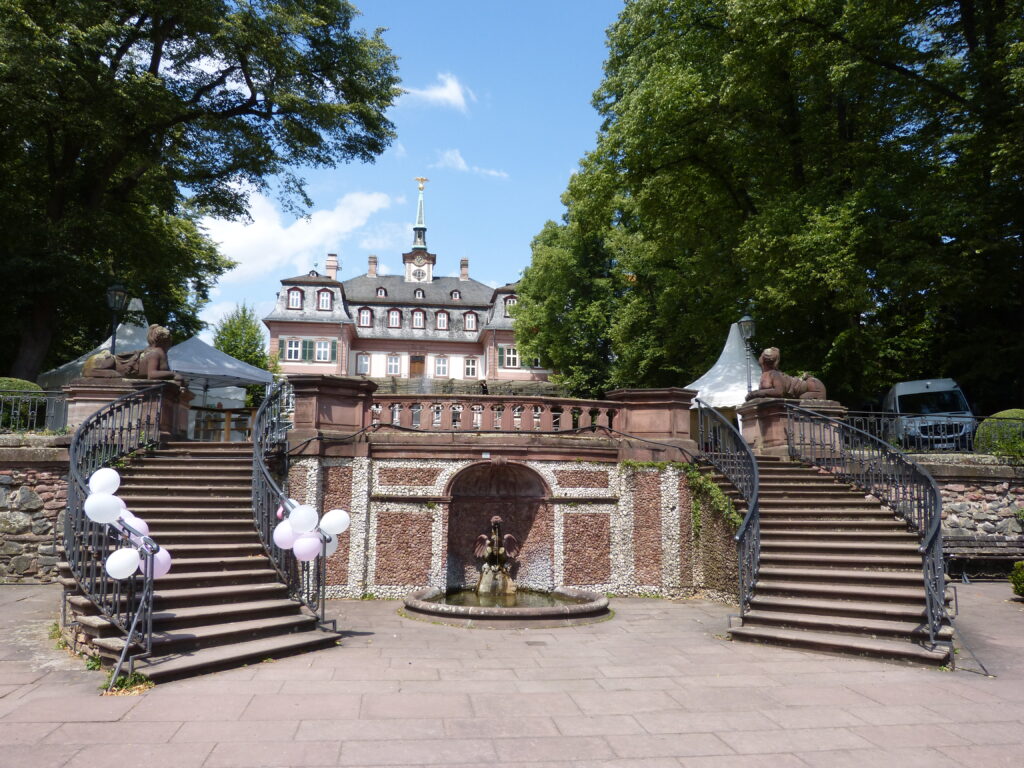
The Bolongaro Palace has a gorgeous garden with fountains and statues, and the day that we visited a wedding was taking place there.
Napoleon even lived at the palace for a while.
Surprise number three was the Justinuskirche or St. Justin’s Church.

It turns out is the oldest building in the Frankfurt area.
It’s also one of the oldest churches in Germany, having been consecrated in 850.
There was a volunteer working in the church who spoke fluent English and was happy to give us a tour.
Even though it was approximately 160 degrees Fahrenheit in the church and we were both sweating profusely, we were very appreciative of his time.
And the surprises continued when we ran across this castle.

Built between the 13th and 16th centuries, it was formerly the residence of the archbishop of Mainz.
With all these unexpected treasures, it’s almost easy to overlook the half-timbered houses, but they’re lovely as well.

Along the river is a restaurant on a boat that is permanently moored there.
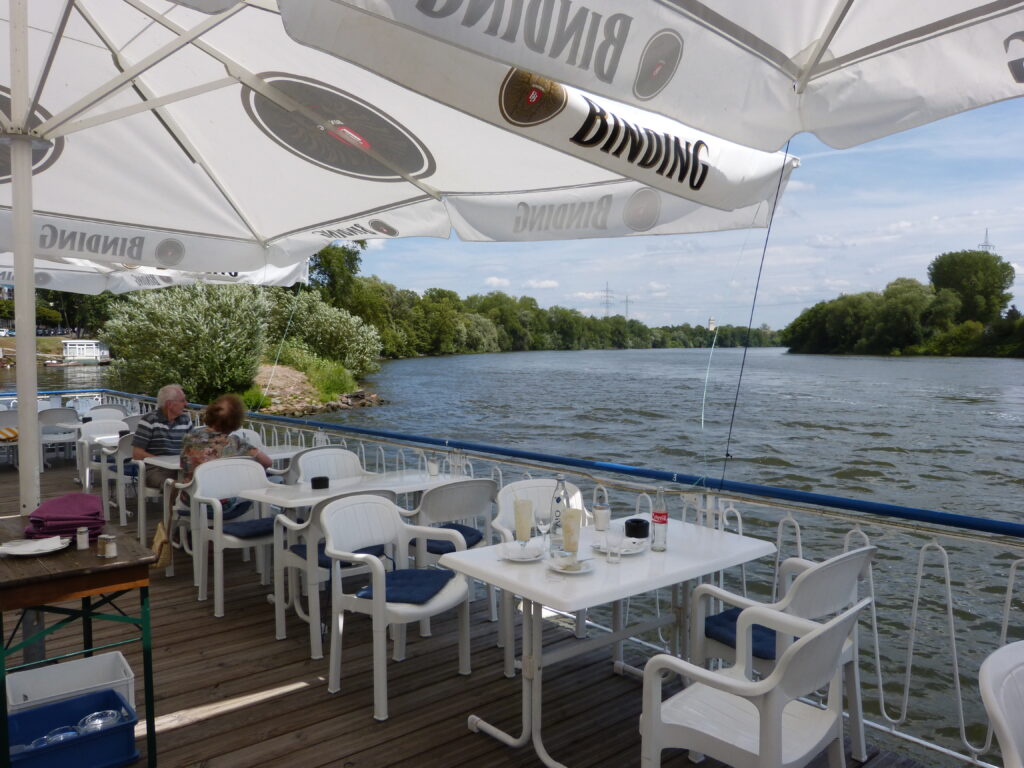
We stopped there to cool off with some ice coffees which, in Germany, actually have ice cream in them.
Unfortunately there were things that we didn’t get to see, including the porcelain factory and the porcelain museum.
The porcelain factory is the second oldest in Germany.
I happen to love porcelain, so I guess I need to squeeze in another trip to Höchst.
Fast-forwarding to this year, on the first day of May we checked out Hadamar.

The intricately-decorated town hall was built in 1639.
This town, like Höchst, actually had a lot more going for it than half-timbered houses.
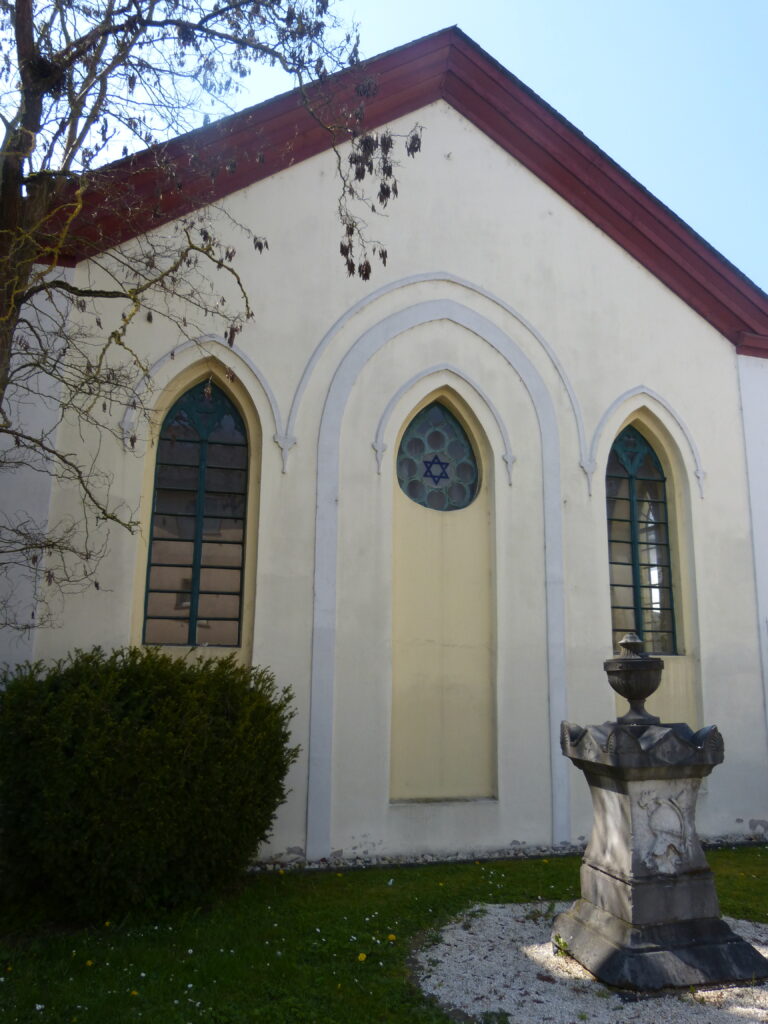
That tiny synagogue was one of the few in Germany that was not destroyed during Kristallnacht in 1938.
A short walk uphill brings you to a peaceful garden.

It’s actually called a rose garden, but it was full of tulips when we were there.
Back in town, I just had to photograph this intricately-carved wooden door.
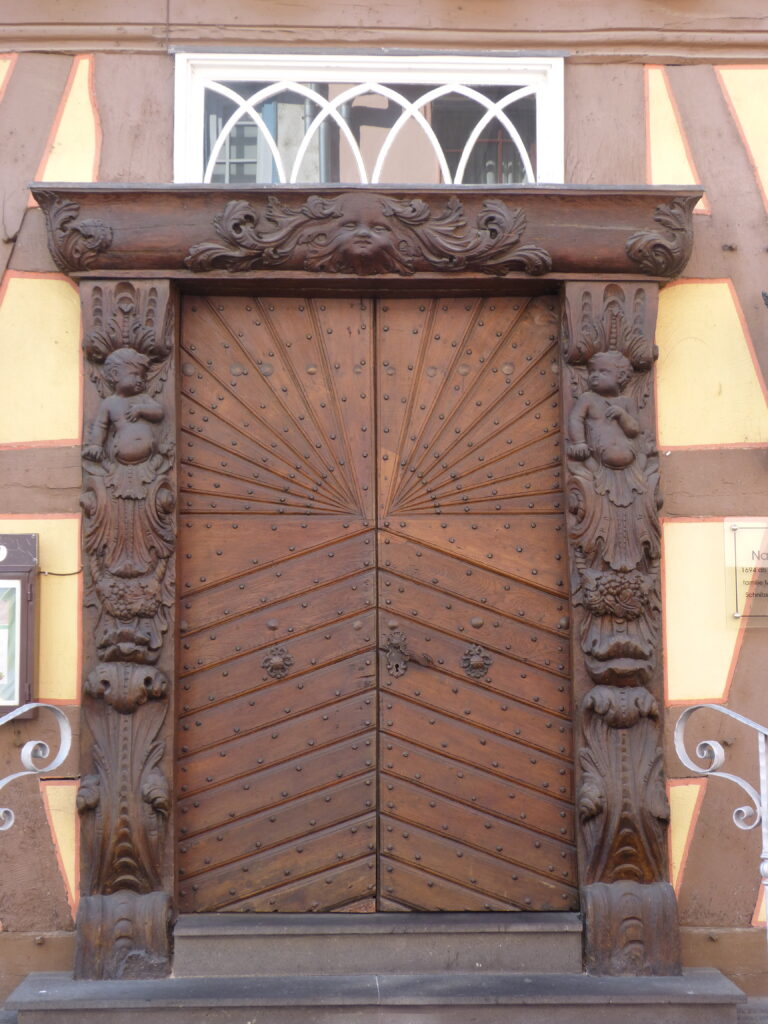
The door is now part of a hotel that was originally a prince’s house, built in 1694.
Isn’t it magnificent?
I’m somewhat obsessed with doors and door handles and have approximately one bazillion photos of them from all over Europe.
As lovely as Hadamar is, it has a dark, infuriating and heartbreaking story from World War II.

That building is part of a psychiatric hospital where the Nazis murdered patients during the war.
They started off sterilizing children who they deemed unfit to reproduce, and later exterminated both children and adults in gas chambers.
The patients were brought in by bus and train, after which various fatal – and false – diagnoses were assigned to them.
In this way they were able to claim that they were performing mercy killings.
Those arriving by bus were driven directly into a garage, and from there they were taken directly to the basement of the building shown above to be killed.
The bus garage now houses an exhibition about the mass murders.

As you can see, Joseph L. was about 15 when he was killed, but children as young as 4 years old were murdered as well.
In total about 15,000 mentally ill and physical disabled people were killed at this facility during the war.
10,000 of them were killed in the gas chambers and the rest were either administered lethal drugs or left to die from neglect and starvation.
The facility is still a mental asylum and treatment center today.
Back to the Half-Timbered House Road, we finished up in Bad Camberg just a couple of weeks ago.
This was the town we had the most difficulty finding information on in English.
Mr. Tipples ended up printing out a walking tour that he found in German and we did the best we could.
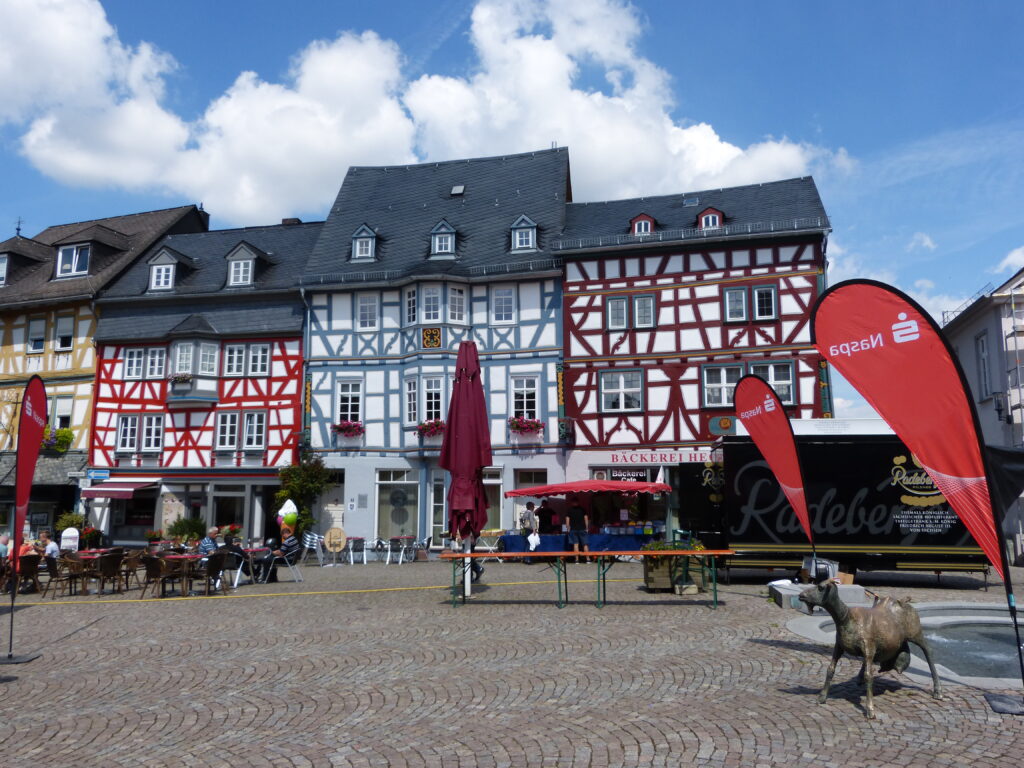
When we arrived, they were setting up a festival in the middle of town.
Germans love to hold a festival at the drop of a hat.
There are, of course, beer festivals but we have also been to the following festivals in Germany: wine, pumpkin, strawberry, Elvis, medieval, fasching (similar to Mardi Gras), international, street, fabric, food truck and pretzel, not to mention various Christmas and Easter markets, which are festival-like.
I’m sure I’m forgetting some, too.
One of the most impressive buildings in Bad Camberg is the Amthof.
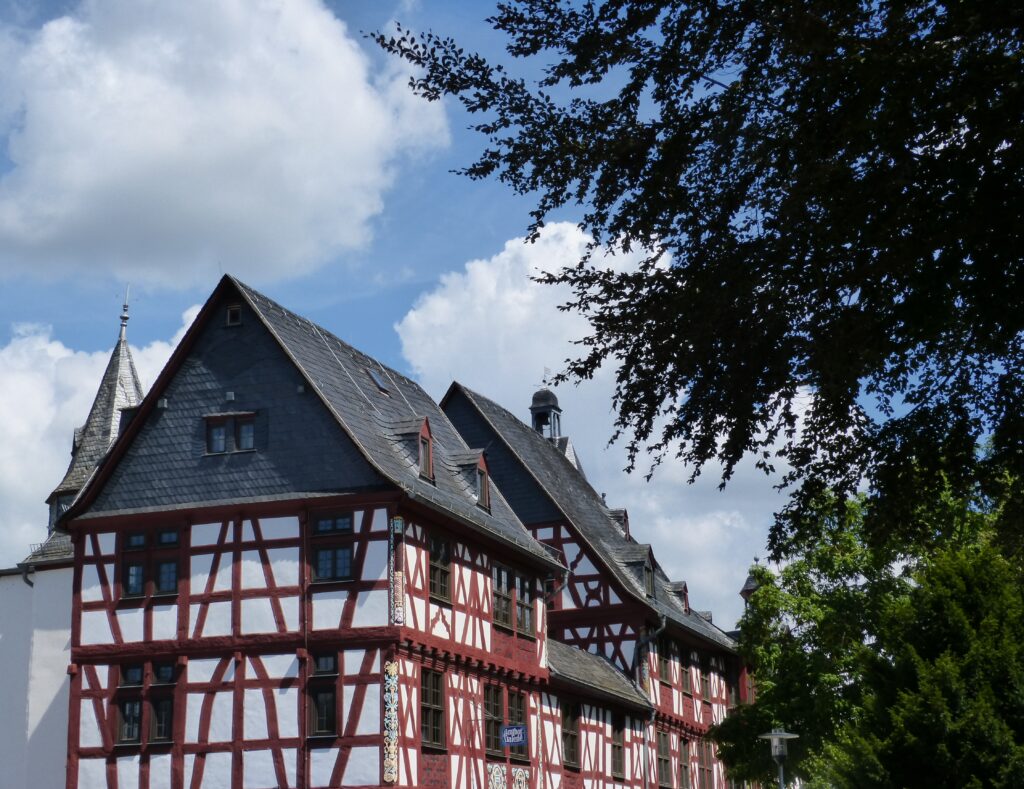
That’s only a small part of it – it’s one of the longest half-timbered buildings in Germany.
Part of it has these carillon bells.
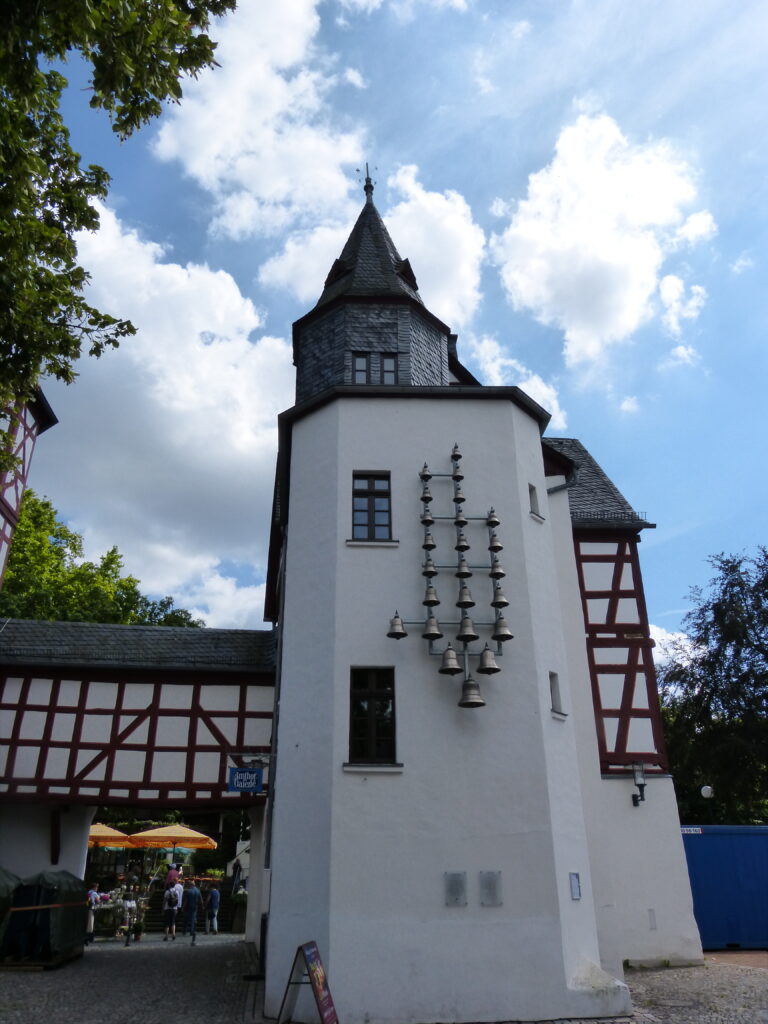
There is a schedule on the side of the tower showing the times that the bells go off and what songs they’ll be playing.
We made sure we were there for the next ringing of the bells and it was so pleasant to sit in that courtyard and listen to them in peace.
It was a hot day so it was also nice to be in the shade under a tree.
There was only one other person there listening, which always surprises me.
We’ve listened to bell “concerts” in other towns and often we are the only ones paying any attention.
The town was pretty crowded for the festival, but nobody else seemed interested in the bells.
A lot of people just rushed through the courtyard on their way to somewhere else and ignored them.
I guess if you live there and hear them every day you become inured to it.
Continuing our tour of the town, we came across this corner with the oldest half-timbered building in Bad Camberg, or so they think. (Whoever “they” is.)
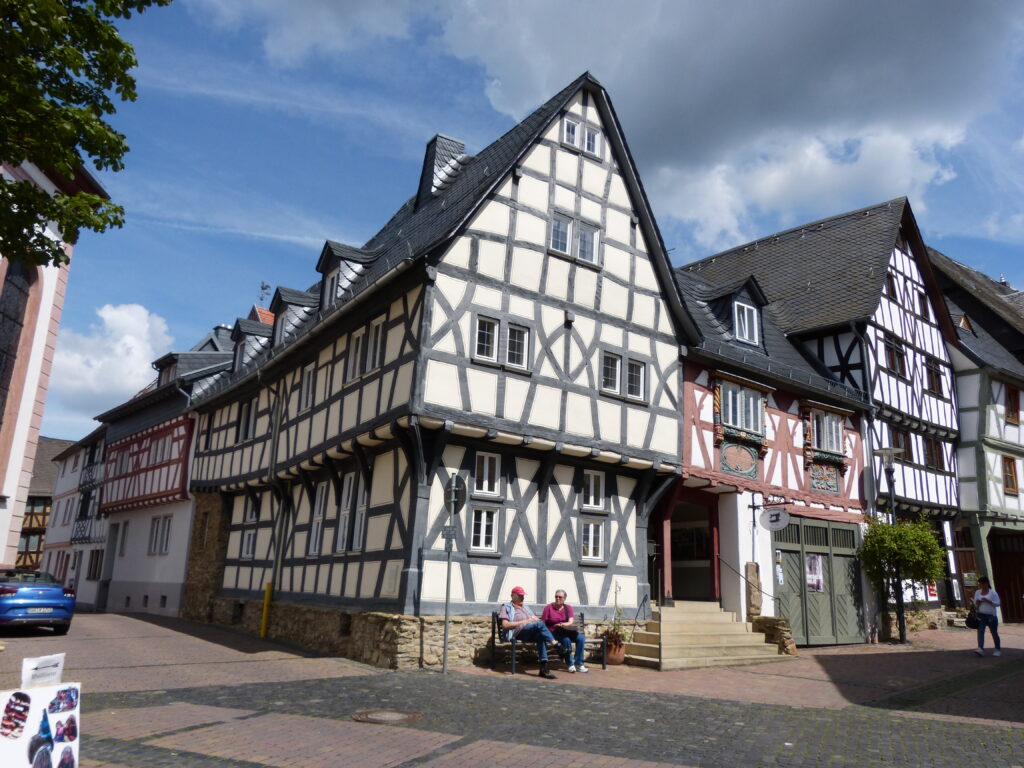
A few hours later, we found ourselves back at the main square and the festival was really getting underway.

You may know or remember from other blog posts on this site that the word Bad in German means bath or spa.
When it’s part of a town’s name, like Bad Camberg, it means there is or was a spa there.
Bad Camberg does have a spa, and next to it is a Kurpark or spa park.
Kur is the German word for cure or treatment.
Spas in Germany are mainly used for medical and rehabilitative purposes, although you can certainly just go for a massage or something if you like.
It’s common to find a spa and a Kurpark together.

To end our day in Bad Camberg, we walked around the entire park, which was also a good break from the heat.
Hopefully it will not take us another four years to complete the next section of this route!

